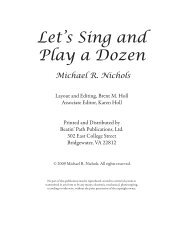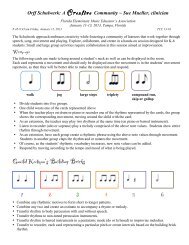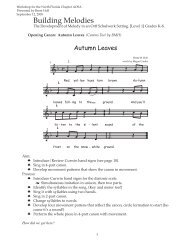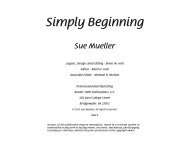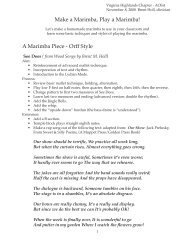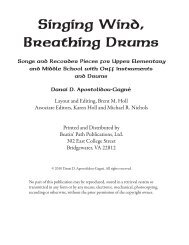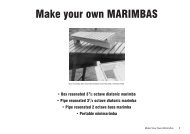Orff Basic Class Notes 2013 - Beatin' Path Publications, LLC
Orff Basic Class Notes 2013 - Beatin' Path Publications, LLC
Orff Basic Class Notes 2013 - Beatin' Path Publications, LLC
You also want an ePaper? Increase the reach of your titles
YUMPU automatically turns print PDFs into web optimized ePapers that Google loves.
Level 1 <strong>Basic</strong> <strong>Orff</strong> Syllabus<br />
Purpose:<br />
The purpose of this class will be to train teachers in the pedagogy and philosophy of <strong>Orff</strong> Schulwerk.<br />
Teachers will be learn about the planning and presentation of lessons in the areas of movement,<br />
classroom performance, listening, and composition by experiencing lessons that are taught using<br />
<strong>Orff</strong> Schulwerk processes.<br />
Objectives:<br />
1. To become familiar with basic movement/dance vocabulary and technique and to develop<br />
the ability to use these skills for communication and creativity.<br />
2. To develop skills in singing, speech activities, recorder playing, and ensemble playing on<br />
the <strong>Orff</strong> instruments.<br />
3. To explore strategies for presenting all types of art music to students in active and creative<br />
ways.<br />
4. To develop writing and orchestration skills in simple forms within the style of <strong>Orff</strong> Schulwerk.<br />
5. To develop the creative ability to experiment with the elements of movement, melody,<br />
speech and rhythm through improvisation.<br />
6. To review and discuss current literature and writings concerning <strong>Orff</strong> Schulwerk processes.<br />
Content:<br />
1. Rhythm: from imitation to creation using convergent to divergent rhythms in duple and<br />
triple meter with speech, body percussion, non-pitched and pitched percussion, singing, and<br />
movement. Question/answer, ostinato, rondo, free rhythmic improvisation. Body percussion<br />
notation.<br />
2. Melody: bitonic, tritonic, folkloric, and pentatonic.<br />
3. Harmony: simple bordun, with its possibilities in 2/4, 6/8, 3/4, 4/4; moving bordun with<br />
5th moving.<br />
4. Timbre: knowledge of the instruments-range, tessitura, sound color; rhythmic and melodic<br />
notation.<br />
5. Form: motive, phrase, antecedent-consequent, period, question-answer, rondo, canon and<br />
two- and three-part song forms (AB and ABA).<br />
6. Active Listening: analysis of specified works of art music emphasizing listening skills and<br />
using speech activities, improvisation, ensemble playing, instrument making and movement.<br />
7. Movement: movement and language; movement and drama; creative movement; movement<br />
with hand drums; basic step vocabulary; and basic folk dance elements.





